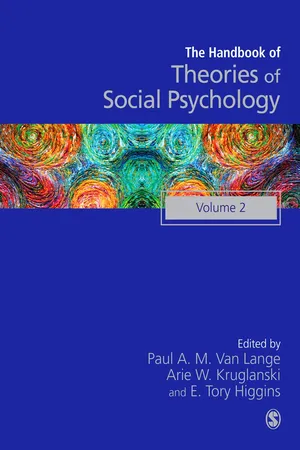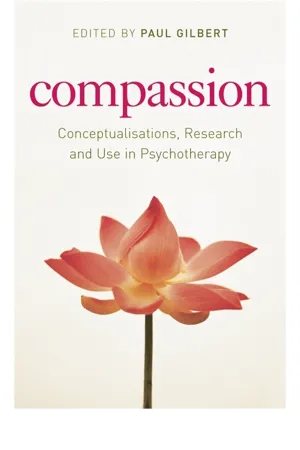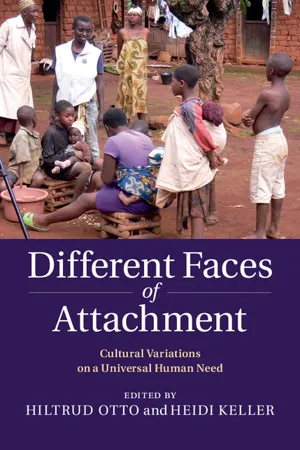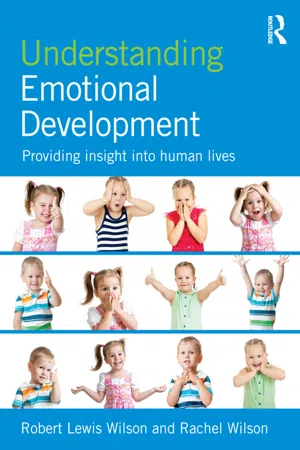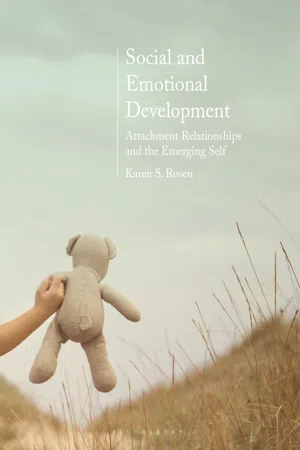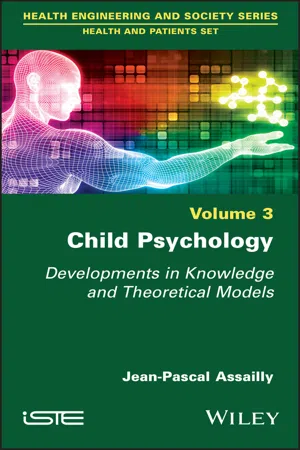Psychology
Attachment Figures
Attachment figures refer to individuals who provide a sense of security and comfort to others, particularly in early childhood. These figures are typically caregivers or parents who play a crucial role in a child's emotional development and sense of safety. The quality of the attachment relationship with these figures can have long-lasting effects on an individual's social and emotional well-being.
Written by Perlego with AI-assistance
Related key terms
1 of 5
10 Key excerpts on "Attachment Figures"
- eBook - PDF
- Paul A M Van Lange, Arie W Kruglanski, E Tory Higgins, Paul A M Van Lange, Arie W Kruglanski, E Tory Higgins, Author(Authors)
- 2011(Publication Date)
- SAGE Publications Ltd(Publisher)
This lifespan orienta-tion encouraged developmental and social psychologists (e.g., Main et al., 1985; Shaver et al., 1988) to extend the theory into the domain of adolescent and adult relationships. During infancy, primary caregivers (usu-ally one or both parents but also grandpar-ents, neighbors, older siblings, daycare workers, and so on) are likely to occupy the role of attachment figure. Ainsworth (1973) reported that infants tend to seek proximity to their primary caregiver when tired or ill, and Heinicke and Westheimer (1966) found that infants tend to be most easily soothed by their primary caregivers. During adolescence and adulthood, other relationship partners often become targets of proximity seeking and emotional support, including close friends and romantic partners. Teachers and supervisors in academic settings or therapists in clinical settings can also serve as real or potential sources of comfort and support. Moreover, groups, institutions, and symbolic personages (e.g., God, the Buddha, or Virgin Mary) can be used mentally as Attachment Figures. This array of real and symbolic fig-ures, which can vary in importance or cen-trality, form what Bowlby (1982) called a hierarchy of Attachment Figures . According to attachment theory, a particu-lar relationship partner is an attachment figure and a relationship is an attachment relationship only to the extent that the rela-tionship partner accomplishes, or is called upon to accomplish, three important func-tions (e.g., Ainsworth, 1991; Hazan and Shaver, 1994; Hazan and Zeifman, 1994). First, the attachment figure is someone to whom the attached individual seeks proxim-ity in times of stress or need. Moreover, separation from or loss of this person elicits distress, protest, and efforts to achieve reun-ion (either literally or, in the case of grief, symbolically). - No longer available |Learn more
- (Author)
- 2014(Publication Date)
- The English Press(Publisher)
In child-to-adult relationships, the child's tie is called the attachment and the caregiver's reciprocal equivalent is referred to as the care-giving bond. Infants form attachments to any consistent caregiver who is sensitive and responsive in social interactions with them. The quality of the social engagement is more influential than the amount of time spent. The biological mother is the usual principal attachment figure, but the role can be taken by anyone who consistently behaves in a mothering way over a period of time. In attachment theory, this means a set of behaviours that involves engaging in lively social interaction with the infant and responding readily to signals and approaches. Nothing in the theory suggests that fathers are not equally likely to become principal Attachment Figures if they provide most of the child care and related social interaction. Some infants direct attachment behaviour (proximity seeking) towards more than one attachment figure almost as soon as they start to show discrimination between caregivers; most come to do so during their second year. These figures are arranged hierarchically, with the principal attachment figure at the top. The set-goal of the attachment behavioural system is to maintain a bond with an accessible and available attachment figure. Alarm is the term used for activation of the attachment behavioural system caused by fear of danger. Anxiety is the anticipation or fear of being cut off from the attachment figure. If the figure is unavailable or unresponsive, separation distress occurs. In infants, physical separation can cause anxiety and anger, followed by sadness and despair. By age three or four, physical separation is no longer such a threat to the child's bond with the attachment figure. Threats to security in older children and adults arise from prolonged absence, breakdowns in communication, emotional unavailability or signs of rejection or abandonment. - eBook - ePub
Compassion
Conceptualisations, Research and Use in Psychotherapy
- Paul Gilbert(Author)
- 2005(Publication Date)
- Routledge(Publisher)
mental representations, with associated emotional and behavioral tendencies). Interactions with Attachment Figures who are available and responsive in times of need facilitate optimal development of the attachment system, promote a sense of connectedness and security, and allow people to rely more confidently on support seeking as a distress-regulation strategy. In contrast, when a person’s Attachment Figures are not reliably available and supportive, a sense of security is not attained, and strategies of affect regulation other than proximity seeking (secondary attachment strategies, characterized by avoidance and anxiety) are developed. In studies of adolescents and adults, tests of these theoretical ideas have generally focused on a person’s attachment style – a systematic pattern of relational expectations, emotions, and behaviors conceptualized as residues of particular kinds of attachment history (Fraley & Shaver, 2000). Initially, research was based on Ainsworth et al. ’s (1978) three-category typology of attachment styles in infancy – secure, anxious, and avoidant – and Hazan & Shaver’s (1987) conceptualization of similar adult styles in the domain of romantic relationships. Subsequent studies (e.g. Bartholomew & Horowitz, 1991 ; Brennan et al., 1998) indicated that attachment styles are more appropriately conceptualized as regions in a continuous two-dimensional space, an idea compatible with early dimensional analyses described by Ainsworth and her colleagues (e.g. 1978: 102). The first dimension, attachment avoidance, reflects the extent to which a person distrusts relationship partners’ goodwill and strives to maintain behavioral independence and emotional distance from partners. The second dimension, attachment anxiety, reflects the degree to which a person worries that a partner will not be available in times of need. People who score low on both dimensions are said to be secure or to have a secure attachment style - eBook - PDF
- Becker-Phelps, Leslie(Authors)
- 2014(Publication Date)
- New Harbinger Publications(Publisher)
Chapter 2 Understanding Why You Relate the Way You Do My goal in this chapter is to clarify the development of attachment styles well enough that you can look at yourself (and your partner) and honestly say, “Well, of course you’re struggling with that. The ways you are thinking and feeling make perfect sense.” As with any problem, the first step toward a solution is to approach it with a positive attitude and true understanding. To start, it’s essential that you understand the attachment system’s three basic functions: Proximity: People naturally strive to keep their attachment figure (usually a parent or romantic partner) close. Safe haven: When people feel threatened, they look to an attach- ment figure for protection, comfort, and support. Secure base: When people feel safe and supported around an attachment figure, they feel freer to pursue goals apart from that relationship. Your experience in adult relationships is very much related to how well each of these functions was met by caregivers during your childhood, and how well they’ve been met by Attachment Figures in subsequent relationships. No, you can’t blame it all on your parents. But a healthy, informed look back can go a long way toward putting you on the road to healthier relationships, by clarifying where you came from. Insecure in Love 26 Proximity: Protection from Danger The safety of young children is dependent on caregivers being close and attentive. Even as children mature into adolescence and young adulthood, they still rely on their parents, though the parent-child relationship changes significantly. They broaden their network of Attachment Figures and so might also rely on other family members, mentors, clergy, or close friends. And then, significantly, they often look to a romantic partner (eventually a spouse) as their principal attachment figure to help them feel safe and to support their interests. However, “closeness” means something a bit different for an adult than for a young child. - eBook - PDF
Different Faces of Attachment
Cultural Variations on a Universal Human Need
- Hiltrud Otto, Heidi Keller(Authors)
- 2014(Publication Date)
- Cambridge University Press(Publisher)
Introduction: understanding relationships – what we would need to know to conceptualize attachment as the cultural solution of a universal developmental task Heidi Keller The definition of attachment as a primary bond between infants and caregivers emerging at around 1 year of age as an evolved adaptation for ensuring survival and development was the seminal contribution of the British psychiatrist and psychoanalyst John Bowlby and his (later) Canadian-American counterpart Mary Ainsworth (Ainsworth, Blehar, Waters et al., 1978; Bowlby, 1969). Attachment theory has initiated a tremendous body of research over the last decades, particularly expand- ing its focus on neurophysiological regulations, and extending it to adult- hood and clinical applications. Nevertheless, the theoretical and method- ological foundations have remained amazingly unaffected, although the basis of knowledge concerning the infant’s socioemotional development has increased substantially since the publication of Bowlby’s well-known trilogy Attachment and Loss and Ainsworth and collaborators’ summary of their empirical research on the emergence of attachment during the first year of life (1978). The first encompassing proposal for the refine- ment of conceptual and methodological issues of attachment theory and research was published by Michael Lamb and collaborators in 1984 in the renowned journal Behavioral and Brain Sciences – though without any observable notice by other attachment researchers. Attachment theory is grounded in evolutionary theory with its basic tenet that every human characteristic is shaped through selection pro- cesses and represents an adaptation to contextual demands. Bowlby stressed explicitly the contextual nature of attachment in his early writ- ings. - eBook - PDF
Understanding Emotional Development
Providing insight into human lives
- Robert Lewis Wilson, Rachel Wilson(Authors)
- 2014(Publication Date)
- Routledge(Publisher)
Attachment originates with the infant and develops into a reciprocal interchange between the child and his or her caregiver that satisfies the child’s most basic dependency needs and allows the child to explore his or her surroundings. The attachment relationship is the baby’s first emotional relationship and if satisfactory is the one from which the child draws emotional comfort and security. Children will seek out the caregiver to whom they are most closely attached whenever they need comfort or when they are injured. Attachment has very close links with a child’s sense of security. Security for the child is based on predictability. The child and the caregiver have had a long period of reciprocal interaction, and they know each other intimately. This allows the child to be able to predict what will happen in the caregiver’s presence. This ability to predict creates a sense of security in the infant and allows the child to explore his or her environment with confidence using the caregiver as a secure base. A sense of security counters anxiety, the emotion that is fuelled by unpredictability. According to Bowlby, the founder of attachment theory, attachment is an enduring emotional tie between infant and caregiver (Bowlby, 1982). Bowlby saw attachment as a way in which infants can reconcile their desire to explore with their wish to be secure and safe. The child uses the caregiver to whom they are attached as a secure base from which to venture into the world, but also as a person to whom they can run whenever danger or strangeness (we would say unpredict- ability) threatens. Attachment and bonding Bonding is a word used in the literature in several senses. Sometimes it is used to mean attachment. At other times bonding is used to mean the attraction that the adult feels for the child, more specifically the feelings of attraction that a mother has towards her newborn infant. - eBook - PDF
Social and Emotional Development:
Attachment Relationships and the Emerging Self
- Karen Rosen(Author)
- 2017(Publication Date)
- Red Globe Press(Publisher)
An extensive body of research supports Bowlby’s idea that early attachment relationships play a critical role in the development of concurrent and later social, emotional, and cognitive competencies. The emotional significance of early attachment rela-tionships is profound and extends throughout the lifespan. Researchers have extended beyond the focus on normative development and studied the developmental outcomes of children who experience threats to the availability of caregivers or disruptions in attachment bonds (for example, when there is parental hostility or inconsistency, maltreatment, or maternal depression). Additionally, attachment theory has been used to guide empirical questions about how early relationships influence the development of par-ticular processes central to adaptation or maladaptation. Thus, for example, developmental researchers have explored the influence of early attachment experiences on developing emotion regulation, behavioral organization, coping strategies, and the construction of cognitive models for representing the self and relationships (for reviews, see DeKlyen & Greenberg, 2008; Egeland & Carlson, 2004; Kobak, Cassidy, Lyons-Ruth, & Ziv, 2006). The quality of the early attachment relationship has been found either to buffer against other risks and serve as a protective factor (for example, secure attachment may protect against the traumatizing effects of abuse) or to increase the risk of maladaptive solutions to developmental tasks (Cicchetti, Toth, & Lynch, 1995). Profound disturbances in attachment relationships have been associ-ated with impairments in children’s social and emotional functioning and may serve as a risk factor for developing psychopathology. These empirical findings have not only deepened our understanding of the processes involved in the development of pathology, but they have also opened new directions for clinical intervention programs. - eBook - PDF
Child Psychology
Developments in Knowledge and Theoretical Models
- Jean-Pascal Assailly(Author)
- 2022(Publication Date)
- Wiley-ISTE(Publisher)
While only half of elder children play the attachment figure role, this brings attachment theory and theory of mind together: to understand that the younger child is stressed, we must be able to understand the emotions of others. There is also a transmission of attachment: it is the securely attached elder children who act as Attachment Figures for the younger children. Finally, the function of the older child also extends to the exploration side of attachment: younger siblings with secure attachment to their older siblings explore the environment more. Attachment theory has thus been progressively extended: initially focused on the mother, it has been extended to the father, then to the siblings, but with different functions and practices. The mother is more competent for the reassurance aspect, the father and the older children for the exploration aspect. However, while attachments with the father and with siblings are considered to be of a different nature than the initial link with the mother, some authors prefer to speak of an “activation relationship” for the first two in order to avoid confusion (Troupel-Cremel and Zaouche-Gaudron 2006). 108 Child Psychology 5.8. Attachment to objects Children form strong emotional bonds with “comforters”, teddy bears, blankets or pillows, for example, and become anxious if separated from them. In Guatemala, children are traditionally given “worry dolls” so that they can share their worries and place them under their pillows. Some children anthropomorphize their objects and refer to them as living beings. Winnicott first described these objects as “transitional”, reflecting his psychoanalytic perspective that they served as a mechanism for the child to develop emotional distance from the mother. Thus, separation from the object was a symbolic separation from the mother. Similarly, Bowlby called these objects “attachment objects“ and suggested that they should be used as a maternal substitute in the mother’s absence. - eBook - PDF
International Perspectives on Early Childhood Research
A Day in the Life
- J. Gillen, C. Cameron, J. Gillen, C. Cameron(Authors)
- 2010(Publication Date)
- Palgrave Macmillan(Publisher)
These needs are met via emotional strivings for intimacy, and Bowlby suggested that these mechanisms intersect with the responsiveness of primary caregiv- ers to protect them from lasting psychological and physiological dam- age caused by their early vulnerability. As a pediatric psychiatrist, Bowlby focused first upon the psychopatho- genic influences of unmet relational needs, but Ainsworth, a student and associate of Bowlby’s, extended his work – as have other develop- mental psychologists – to include the development of positive, secure, early experiences as well as experiences of insufficient or distorted early relationships (Ainsworth, 1967; Bretherton, 1992; Main, 1990; Mayhew, 2006). A major premise of attachment theory is not simply the protec- tion that early secure relationships provide for children in building representations of healthy relationships and mental models of self and others that are sources of emotional strength in times of trouble. It also Cameron, Talay-Ongan, Hancock and Tapanya 79 posits that early relationships provide the young child with emotional strength and a notable drive to explore the environment, a critical fac- tor in healthy social and cognitive growth (Bowlby, 1988). Subsequent research has additionally confirmed that biology is not destiny. Positive early experiences are neither necessary nor sufficient precursors of later thriving; however, favourable experiences are potential building blocks for later well being. Furthermore, we now know that early security does not ensue from a single early relationship but rather can be successfully built out of positive experiences with a number of sensitive, responsive caregivers. The keys are sensitivity and responsivity in caregiving and mutuality in interactivity. The concept of attachment security and the hypothesized impacts of early intimate experience on later thriving have not gone uncontested. - eBook - PDF
Engaging with Fathers
Practice Issues for Health and Social Care
- Julie Taylor, Brigid Daniel(Authors)
- 2001(Publication Date)
- Jessica Kingsley Publishers(Publisher)
So a child whose main attachment experience is avoidant is likely to appear stand-offish and to bring about the same kind of relationship with others. What is also known, however, is that, with experience of different kinds of relation-ships, it is possible for the predominant inner working model to change. The answer to the question is, therefore: · Types of attachment are usually related, but need not always be. The need for, and demonstration of, attachment develops from birth and is the expression of a powerful biological imperative. It is a primeval and, at least initially, involuntary and instinctive behaviour. The important conclusion is that, from the tiny baby’s point of view, the gender, and indeed the familial relationship of the attachment figure, is beyond their capacity to consider. From the point of view of the child, the essential requirement is for another human being, preferably one who is more mature, to be the object of attachment. From the adult’s perspective From the point of view of the adult the situation is rather different. As well as being a biological event, the birth of any baby is also a social ATTACHMENT / 79 event and is given its social meaning by the people involved. A child is born into a society with structures and role expectations and to people who carry their own interpretation of social structures and expecta-tions. For the adult the situation is more complicated than for the child. The child is obviously at the mercy of adult circumstances; the adult, however, is subject to biological, social, cultural, emotional and experi-ential forces. The attachment role the father takes depends on a range of factors. The factors that contribute to the adult being in a state of readi-ness to become an attachment figure who will promote secure attach-ment have been studied. Most of the work has been carried out with women and more research focused specifically on men is needed.
Index pages curate the most relevant extracts from our library of academic textbooks. They’ve been created using an in-house natural language model (NLM), each adding context and meaning to key research topics.
